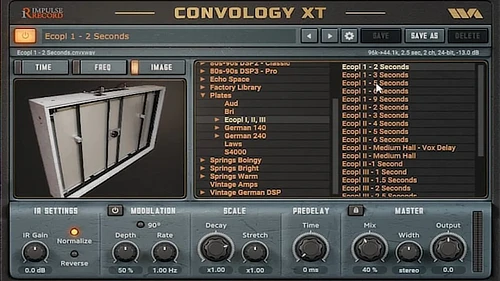The A/D and D/A converters in the Lexicon M300 use oversampling techniques to minimise low-level distortion and provide linear phase characteristics. 64x oversampling Delta/Sigma conversion is used in the A/Ds; 8x oversampling is used in the D/As. The result is sonic transparency without the artifacts normally encountered in conversion.
The digital I/O simplifies interfacing with both the AES/EBU professional and the EIAJ consumer format. XLR, RCA and Optical connectors are provided for both input and output.
The digital inputs of the Lexicon M300 will automatically accept and lock to any AES/EBU/SPDIF format; the Lexicon 300’s digital output format is user-selectable for feeding either professional or consumer equipment. This allows for format conversion as well as using the high-quality A/D converters to feed digital recorders. Control of additional Channel Status information is provided as well.
The Lexicon M300 utilises two proprietary high performance DSP engines. The configuration of these engines can be determined by the end-user to suit a particular audio application. The Single Setup configuration unites both DSP engines. Two “split” configurations: Dual Mono and Cascade, allow each DSP engine to run a special program especially designed for “Split “ applications.
The Single algorithms include: Random Hall, Random Ambience, Rich Plate, Stereo Pitch Shift, and Stereo Adjust. The “split” algorithms include: Dual Delays, Chamber, Mono Pitch Shift, Compressor, a special mastering dither program called PONS (Psychoacoustically Optimised Noise Shaping), and a small version of Stereo Adjust.
The Lexicon M300 makes effects automation available in three different ways. If you use time code, the Lexicon M300’s Event List and Time Code Reader add a new twist to effects processing. Each entry in the 50-item list contains a time code value and a 300-effect preset/register number, allowing incoming time code to trigger setup and effect changes, as well as setup and effect parameter glides. For changing effects in music or changing rooms and environments for film and video, the Lexicon M300’s time code capability opens new avenues to all time code users.
Dynamic MIDI is included for real-time performance control and effects automation. All parameters in the Lexicon 300 can be patched to most MIDI controllers, allowing full control from remote devices. For full MIDI automation all parameter changes can be recorded on any sequencer. For additional control, complete System Exclusive information is available.
Even with the best functions and features, the heart of any signal processor is its sound. The Lexicon M300 contains the very best of the Lexicon Sound – with new refinements such as dynamic size parameters in the Reverb and Ambience algorithms.
We have also included stereo and mono pitch shifting, delay effects, a mastering algorithm with precision level/balance controls and equalisation. These sounds, combined with analogue and digital audio I/O, time code-based effect change, an internal LFO, and full MIDI automation result in a system that provides new creative options each time you use it.
The most critical aspect of the Lexicon M300 is its Setup and how it integrates with the digital effects you want to use. The Lexicon M300 offers three types of Setups: Single, Dual Mono, and Cascade. Each one is uniquely different and, when combined, provide a broad range of audio possibilities.
Each Setup includes one or more effects along with elements such as machine inputs, source balances, wet (effect) and dry (input) mix levels for each machine, meter functions, LFO rates and shapes, and a naming function. Additionally, there are two modulation patches that link source controllers to two Setup parameters.
To simplify navigating the numerous effect and system routing options, the Lexicon M300 comes preloaded with 100 Setup Presets. These factory presets cannot be overwritten but can be modified and saved as User Setups in any of the 50 available Setup Registers.
Setup Presets
- 101-150: Single Setups
- 201-225: Dual Mono Setups
- 301-325: Cascade Setups
Single Setups consist of one effect running in a single unified machine, with both DSP engines operating as one. Dual Mono and Cascade configurations are “split” setups that can run two different (or identical) effects simultaneously.
The Lexicon M300 is all about audio effects, and it includes 100 Effect Presets that can be loaded into the three Setup types. There are five algorithms available for Single Setups: Random Hall, Random Ambience, Rich Plate, Stereo Pitch Shift, and Stereo Adjust. The “split” Setups (Dual Mono and Cascade) can accommodate six algorithms: Dual Delays, Split Chamber, Mono Pitch Shift, Compressor, PONS, and Small Stereo Adjust.
Each algorithm has its own set of control parameters. For example, Random Hall offers 28 parameters. These can be adjusted using the front panel EFFECT EDIT key and the Soft knob, significantly altering the effect. An effect can also utilise up to 4 patches, each linking a source controller to a parameter. This MOD EDIT function is an extension of the EFFECT EDIT function, and saving one also saves the other. Although Effect Presets cannot be overwritten, they can be modified and stored as custom Effects in any of the 50 Effect Registers.
Effect Presets
- Single Setups (101-150):
- 101-115: Random Hall Presets
- 201-210: Random Ambience
- 301-308: Rich Plates
- 401-409: Stereo Adjust
- 501-508: Stereo Pitch Shift
- Split Setups (201-325):
- 601-616: Dual Delays
- 701-720: Split Chambers
- 801-810: Mono Pitch Shift
- 901-902: Compressor
- 001: PONS Program for Mastering Applications
- 010: Small Stereo Adjust
The Lexicon M300 is structured around Setups and Effects. Setups consist of various configuration decisions, such as DSP routing, input levels, source balances, LFO rate and shape, and one or more effects. These configurations are grouped, named, and saved for easy recall. Each effect within a Setup includes an algorithm, a complete set of parameters, and 4 patches. Similar to Setups, Effects can be loaded, copied, edited, named, saved, and managed via MIDI.









